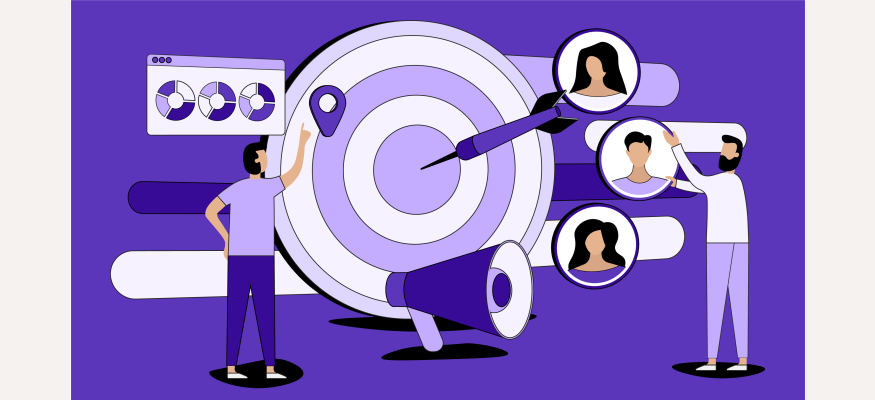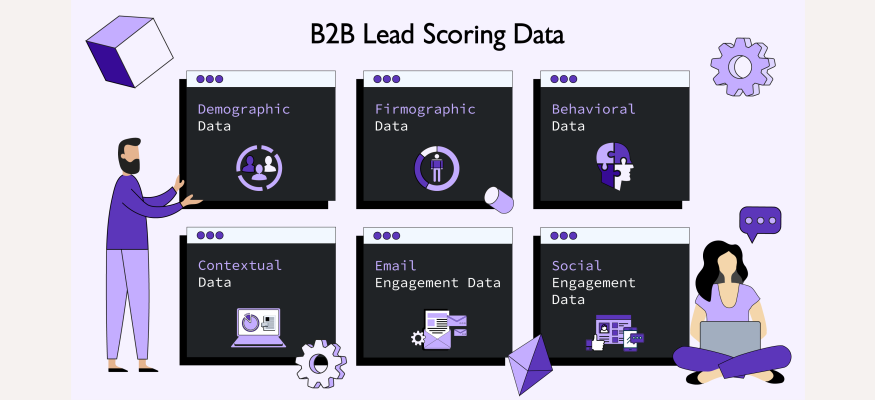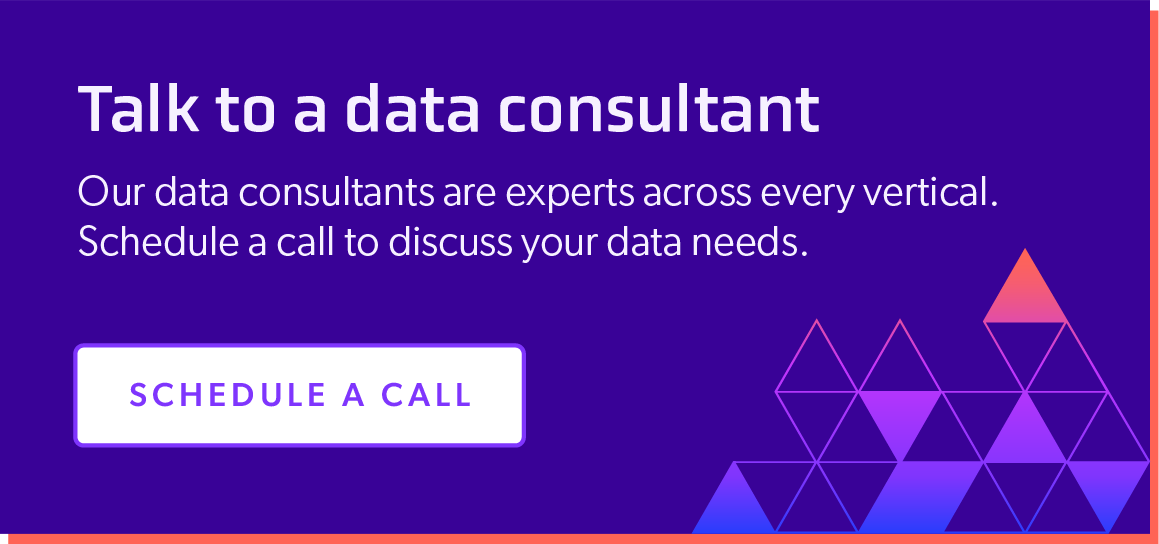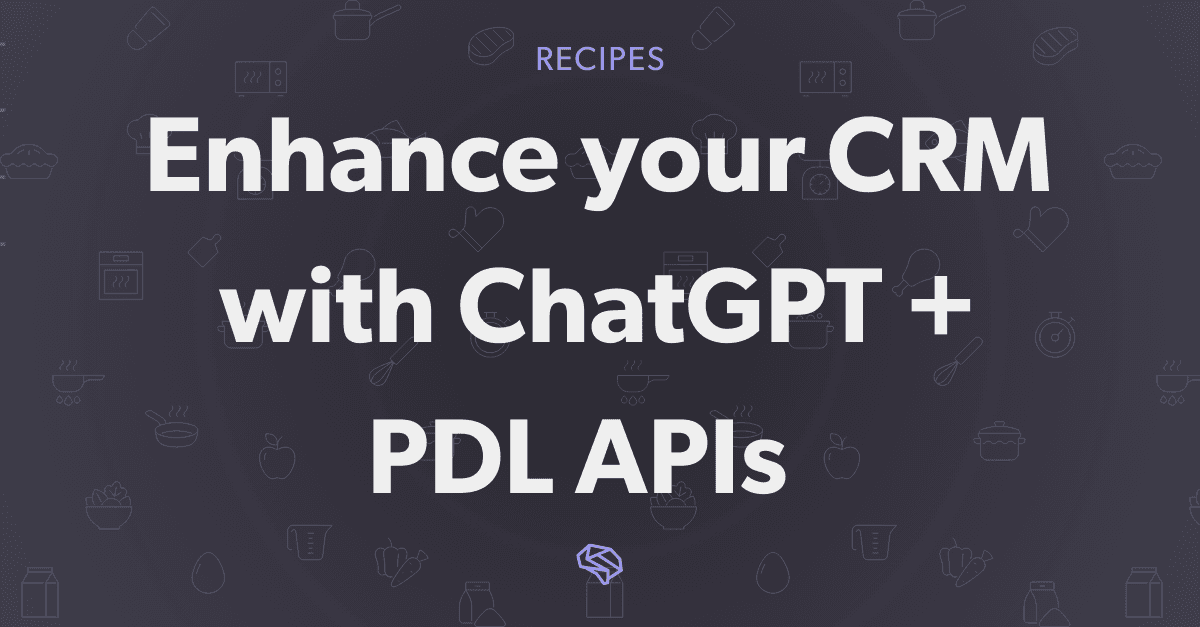
The Complete Guide to B2B Lead Scoring
March 1, 2021
Table Of Contents

Ok, so you’ve got leads, but not every B2B prospect is created equal. There’s nothing worse than pouring hours of effort into a lead that doesn’t convert, or securing an opportunity that isn’t worth the time and resources it took to win. What if you could know in advance how likely it is that a prospect will become a customer? Even better, what if you could know the approximate value of a lead before you even begin your outreach? Lead scoring makes that possible, and this guide will provide you with step-by-step instructions and powerful tactics to do just that.
What is Lead Scoring
Lead scoring is a set of methodologies and practices that businesses use to analyze incoming leads and rank their potential value to the organization. This ranking is used to determine the order in which sellers and sales development representatives engage with a lead, and the amount of effort and resources allotted to win a given opportunity.
Lead scoring allows sales and SDR teams to better manage time and resources based on the relative value of every potential customer. Leads can be scored on a variety of factors, from likelihood that they’ll convert, to potential lifetime value, depending on the specific needs of a given business. Scoring leads ensures your sales efforts are optimized around the needs of the organization and that your efforts are focused on the best possible leads. Lead scoring allows sales and SDR teams to prioritize their efforts based on the value that each potential lead represents to the business, and to target specific types of leads based on the specific customer and revenue goals of the organization.
Why is lead scoring important for B2B companies?
Lead scoring allows B2B businesses to increase the efficiency of their sales and marketing processes and to improve the overall quality of the leads generated by identifying the prospects and opportunities that will have the most impact on their business. A robust lead scoring strategy ensures that sales and marketing teams can minimize their total efforts and use of resources while maximizing their results.
An effective lead scoring strategy provides a variety of unique benefits to B2B revenue organizations:
Easier and More Effective Lead Qualification
With predetermined criteria for lead qualification, the process can be streamlined and automated. Lead scoring is a data-driven approach, meaning that new leads can be evaluated based on the common behaviors, traits, and demographic characteristics of past leads, allowing marketing teams to quickly determine which leads are ready to convert and which require additional lead nurturing efforts.
More Effective Sales and Marketing Campaigns
Understanding the value of specific lead types and the qualities and behaviors of high-value leads will allow sales and marketing teams to build more effective campaigns to capture and nurture the desired lead types in higher volumes. Optimizing campaigns based on lead scoring criteria ensures more strong leads and fewer low-value leads to weed out.
Increased Revenue
Increasing the efficiency of sales and marketing efforts through effective lead scoring will drive bottom line revenue and help to eliminate waste by ensuring that most resources are deployed toward the highest value leads.
Improved Lead Quality
A sophisticated B2B lead scoring process should include criteria around the potential value of a specific conversion. By optimizing efforts around these high-value leads, overall lead quality will improve as low-quality and low-value leads are screened out through automated and semi-quationated qualification processes.
Higher Conversion Rates
Lead scoring allows your team to rank leads based not just on demonstrated interest in your product or service, but also on the likelihood that they are nearing a decision. By focusing the majority of your efforts on leads that are already within striking distance of a conversion, business can dramatically increase their conversion rate. This is particularly valuable for B2B businesses with long sales cycles.
B2B Lead Scoring Models
A business’ lead scoring model is the framework they use to evaluate and rank incoming leads. This lead scoring model of a particular business will vary depending on the needs and goals of the particular organization and the data the business is able to collect on its leads. Demographic data, firmographic data, behavioral data, contextual data, email engagement data, social engagement data, and spam detection all play a role in determining how leads are screened and ranked within your lead scoring model.

Demographic Data
Data about the individual lead contact can provide insight into their potential value and likelihood to convert. Demographics include data points like age, gender, location, and job title. You can use this information to screen out leads from locations where you do not sell as well as from titles and roles that are unlikely to buy your specific service, and to prioritize those from high value locations or with decision maker titles.
Firmographic Data
Also known as company data, firmographic data is data about the company or organization to which a lead belongs such as size, annual revenue, market segment, and vertical. Armed with this information, you can screen out leads from businesses that are not likely to be strong sales prospects, industries in which you do not do business, and firms that are too large or too small to avail themselves of your services or products. Likewise, firmographic data can be used to focus efforts on high value targets in desired markets and companies which match the profile of existing customers.
Behavioral Data
Understanding a lead’s online behavior can provide clues about their readiness to convert. Details like a high volume of visits to your site, increased frequency of visits, and page visits all provide insight into where a lead might be in their decision process. Rising or falling frequency of visits and the sequence of pages visited in a given engagement can provide clues to how close a lead is to conversion.
Contextual Data
The specific pages that a lead visits may also provide clues to their potential value and should be used to inform their rank within your lead scoring schema. Visits to high-value pages like pricing comparisons, which signal intent to buy, can be ranked higher due to demonstrated signs that they are close to conversion. Browsing lower-value introductory pages may indicate a lead just beginning their purchase journey.
Email Engagement Data
The way a lead responds to your email marketing campaigns can indicate how they should be ranked. Open rates and click-thru rates on marketing emails are strong indicators of interest that should contribute to a higher ranking.
Social Engagement Data
Like email, social media engagement can provide a strong indicator of interest and intent. Leads that like, reply, share, or otherwise engage with your posts can be ranked higher based on this demonstrated interest.
Spam Detection
Some lead generation activity produces spam. If a prospect has provided obviously wrong, erroneous, or willfully incomplete information then they are unlikely to convert. These leads should consequently be ranked lower and screened out before any resources are applied to their development .
What Types of Behavioral Data are Important When Scoring Leads?
Let’s dig deeper into behavioral data. The way that a lead engages with your content and the way they navigate on and off your site can provide powerful indications of their level of interest and their likelihood of converting. Page views, email opens, downloads, visit frequency, searches, and participation in content programs, like webinars, are all significant indicators of interest that should contribute to a higher rank for a given lead.
Page Views
A lead that visits your pages frequently is indicating interest in the product. Increasingly frequent visits may indicate that the lead is close to making a decision.
Email Opens & Email Click-thrus
Opening emails, especially opening the same message multiple times as well as clicking links to further engage with email marketing content indicates a higher level of interest and should increase a lead’s score.
Visits to multiple pages
Like frequent visits, visiting multiple pages in a single session is a strong indicator of interest. Especially if those visits are to high value pages like pricing or documentation which indicate a more advanced stage of consideration.
Downloading Assets
Downloading a gated asset such as an ebook, guide, or one-sheet suggests that a lead is engaged in more than just cursory research and that they may be nearing a decision that leads to conversion.
Searching Targeted Terms
Your lead scoring strategy should align with your keyword strategy. If you’ve identified high-value keywords that attract your desired leads, anyone searching for one or more of those terms should have that reflected in their lead score.
Webinar Views
Viewing a webinar, livestream, or other multimedia event produced by your marketing team points to a high degree of interest and a desire to learn more than what’s available on your site. Score these leads accordingly.
B2B Lead Scoring Best Practices
Lead scoring is a team effort that involves your sales and marketing team. An ideal lead scoring process will require you to marshall your data resources, build a working understanding of your customer journey, and constantly improve and optimize based on sales feedback and results. A few tips to keep in mind:
Sales/Marketing Communication
Lead scoring is a collaboration between the sales and marketing sides of your revenue organization. Quality lead scoring requires data from outbound marketing efforts as well as feedback and measurable results from sales metrics. Both teams should collaborate to build the most effective lead scoring scheme based on the data available and the needs of the business, as well as to continually optimize lead scoring based on results and changing market conditions.
Enrich your Data
Lead scoring relies on knowing as much as possible about each individual lead and analyzing that data in the context of your sales pipeline. Data enrichment can add valuable demographic and firmographic data to individual leads to help you make more informed and accurate decisions about lead scores, but the ability to to improve lead quality hinges on access to quality data. People Data Labs prides itself on building the freshest, most accurate B2B datasets on the market to power lead enrichment.
Understand the Customer Journey
In order to interpret behavioral data it’s important to understand the ins and outs of your typical customer journey. Knowing the common steps customers take on their way to conversion will help you to assess where each lead stands on that journey and how much effort should go into getting them across the line. Their stage in the customer journey should be reflected in their lead score. The more advanced their journey, the higher their score.
Establish lead scoring thresholds
Not every lead is ready to be pursued. Once you have established lead scoring criteria, it’s also important to establish threshold scores that determine when a given lead is considered marketing qualified and handed over to sales rather than passed back to marketing for continued nurturing.
Use Negative Scoring
Lead scoring is not a one way street. While there are a number of factors that can increase a lead's score based on how likely they are to convert or how great their potential value to the organization, there are also signals that should reduce a lead score. Negative lead scoring criteria allow your organization to exclude bad leads, low-value leads, and non-leads from your pipeline when they are unlikely ever to qualify. Some common negative scoring criteria include locations where you do not operate, and firms that are too small to utilize your services and/or too large for you to service.
Set Separate Scoring Models
Many B2B businesses offer a range of products and services. It’s possible to have more than one kind of idea lead for each service, so you may wish to establish different scoring models for different products to ensure that you generate and advance the best leads for each.
Reevaluate your Lead Scoring Model Regularly
A lead scoring model isn’t static, it changes with the nature and needs of your business as well as the conditions of the market. A top lead today may be a low-priority lead a year from now as circumstances change. Sales and marketing should work together to regularly reassess the effectiveness and accuracy of the lead scoring model your organization employs and to make incremental improvements over time based on results.
Types of Lead Scoring
Lead scoring models vary depending on the needs and capabilities of the given company and your lead scoring process is likely to vary widely as well. There are several different approaches to lead scoring and the one that’s right for you will depend largely on the data and resources you have available as well as the volume of leads you receive.
Manual Lead Scoring starts with establishing a set of criteria around what makes for a strong lead. These qualities will vary based on the unique qualities of your sales and marketing pipeline, and there may not be a one-size fits all answer. Start by looking at the lead attributes that contribute to a high close rate. These attributes should contribute to a higher score in your model. Once you’ve made this assessment you’ll need to assign points to all the attributes and actions you’ve identified. It may help to choose a set of high-quality leads that have recently closed and work backwards identifying the traits that made them successful and assigning higher point values. The ultimate result should be a set of scoring criteria that would have given your recent top-performing leads a high score. These high scoring leads should align with your ideal customer profile.
Probability-Based Lead Scoring leverages the manual lead scoring work that you’ve already done to identify the key attributes and actions associated with high quality leads. Once you’ve identified these attributes and actions and weighted them appropriately, you can use them to create a formula that assesses each lead based on the probability that it will eventually become a high quality lead based on your existing scoring parameters. As a new customer enters the funnel, their behavior will be compared to past customers in order to determine how likely they are to follow a similar lead path. These probabilities can help you to determine which leads are worth pursuing.
Predictive Lead Scoring layers machine learning algorithms on top of third-party data to assign scores based on demographic, firmographic, and intent data. Predictive lead scoring continuously improves as more data becomes available and more leads enter and either complete or abandon the funnel. The more data available, the more accurately predictive algorithms will be able to identify patterns of common attributes that lead to a successful conversion. Whereas, manual and probability-based lead scoring requires ongoing direct effort to maintain. Predictive lead scoring continues to improve autonomously over time to produce a more accurate result.
Lead Scoring vs Lead Qualification
It’s easy to see some overlap between lead scoring and lead qualification, but the two practices serve very different functions within a revenue organization.
B2B lead scoring is a way of assessing B2B leads to determine which receive the most attention, resources, and effort based on their potential value to the organization.
Lead qualification is the process through which leads that have met certain criteria are advanced through the sales and marketing pipeline. In other words, B2B lead scoring is an assessment of the quality and possible value of a lead before any targeted effort has been made to close it.
A lead score determines how hard the various parts of an organization should work to bring a lead to maturity and conversion to ensure that those efforts are optimized. A lead qualifying process is the set of practical signals and actions that move a quality lead along that pipeline with no eye toward its potential value.
Next Steps
Once you’ve established a working lead scoring model and secured the right types of feedback to continually improve and optimize it, you’re ready to move on to next steps. Lead scoring is a tool that helps your team to apportion its efforts. High-scoring leads should receive more attention from sales and marketing and only leads that meet a lead score threshold should be pursued. This ensures that effort isn’t wasted on false, low-quality, or low-value leads and that the bulk of your team’s effort is concentrated on securing the leads that will have the biggest impact on your business.
With a lead scoring model in place, you’re ready to start evaluating leads and improve your sales and marketing funnel to ensure that the majority of leads you generate are high quality. Focusing on boosting lead scores can be an effective proxy for pipeline improvement because your efforts will be optimized on driving interest from your ideal customers from the earliest stage rather than on simply generating high lead volume. The end result of this process should be more leads advancing more quality from the marketing qualified lead stage (MQL) to the sales qualified lead stage (SQL), and ultimately more leads converting at a higher revenue value.
If you’re looking to start building out your B2B lead scoring process, or to enhance the process you already have in place, then data is a key piece of the puzzle. Additional demographic and firmographic data can dramatically enhance your ability to assess the potential value of leads and make your lead scoring process more efficient and effective. To learn more about People Data Labs’ high-quality, always-accurate B2B data, visit our website and request a free API key.
Like what you read? Scroll down and subscribe to our newsletter to receive monthly updates with our latest content.



